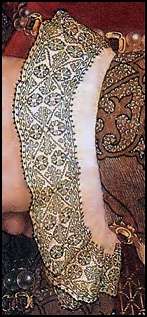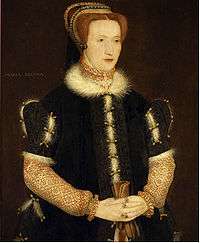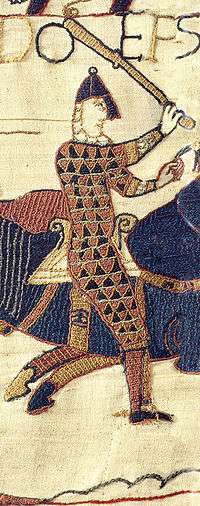Blackwork

Blackwork, sometimes historically termed Spanish blackwork, is a form of embroidery generally using black thread, although other colors are also used on occasion.[1] Sometimes it is counted-thread embroidery which is usually stitched on even-weave fabric. Any black thread can be used, but firmly twisted threads give a better look than embroidery floss. Traditionally blackwork is stitched in silk thread on white or off-white linen or cotton fabric. Sometimes metallic threads or coloured threads are used for accents.
Scarletwork is like blackwork, except it is sewn with red thread.
Technique
The stitches used for counted thread blackwork are double running or holbein stitch, backstitch, and sometimes stem stitch. Historically it was done on plain weave fabric. Modern stitchers often use even weave fabric made especially for counted thread work.
Historically, there are three common styles of blackwork:
- In the earliest blackwork, counted stitches are worked to make a geometric or small floral pattern. Most modern blackwork is in this style, especially the commercially produced patterns that are marketed for hobby stitchers.
- Later blackwork features large designs of flowers, fruit, and other patterns connected by curvilinear stems. These are frequently not counted thread work and are outlined with stem stitch, and the outlined patterns are filled with geometric counted designs.
- In the third style of blackwork, the outlined patterns are "shaded" with random stitches called seed stitches. This style of blackwork imitates etchings or woodcuts.
History

Historically, blackwork was used on shirts and chemises or smocks in England from the time of Henry VIII. The common name "Spanish work" was based on the belief that Catherine of Aragon brought many blackwork garments with her from Spain, and portraits of the later 15th and early 16th centuries show black embroidery or other trim on Spanish chemises.[2] Black embroidery was known in England before 1500. Geoffrey Chaucer in the Canterbury Tales describes the clothing of the miller's wife, Alison: "Of white, too, was the dainty smock she wore, embroidered at the collar all about with coal-black silk, alike within and out."
Blackwork in silk on linen was the most common domestic embroidery technique for clothing (shirts, smocks, sleeves, ruffs, and caps) and for household items such as cushion covers throughout the reign of Elizabeth I, but it lost its popularity by the 17th century. (See also 1550–1600 in fashion.)
Historic blackwork embroidery is rare to find well-preserved, as the iron-based dye used was corrosive to the thread, and there are currently no conservation techniques that can stop the decay.[3][4] Black embroidery silk from outside England, such as Spain, contained less iron in the black dye and so blackwork worked using non-English silk tends to survive in better condition.[5]
16th-century blackwork
-

Geometric Scarletwork, Venice, 1520s.
-

Blackwork embroidery on both an outer and inner collar. Portrait of Simon George by Hans Holbein the Younger, 1535.
-

Blackwork embroidery in Holbein stitch. ail of portrait of Jane Seymour by Holbein, 1537.
-

Bess of Hardwick in geometric Scarletwork, 1550s.
-

Blackwork sleeves with large free-stitched flowers filled with geometric patterns, under sheer linen oversleeves, and a counted Blackwork forepart under her skirt. Portrait of Mary Cornwallis by George Gower, c. 1580.
-

Elizabeth I wearing free-stitched Blackwork sleeves, stomacher, and collar (beneath a sheer linen ruff), c.1590.[1]
-

English Blackwork cushion cover, late 16th century. Linen embroidered with silk and metallic thread, in a mix of counted and free-stitched stitches, including buttonhole, chain, double running, overcast, plaited braid, and square open work stitches. Art Institute of Chicago textile collection.
- ^ Arnold, Janet, Queen Elizabeth's Wardrobe Unlock'd, pp. 40–41
Modern blackwork

Blackwork remains popular. Common subjects among hobbyists include chessboards, maps, Tudor houses, roses and cats. Much of the success of a blackwork design depends on how tone values are translated into stitches.
Today, the term "Blackwork" is used to refer to the technique, rather than the colour combination.
-

Framed Celtic design in blackwork
-

Map of Derbyshire
Notes
- ↑ Leslie, Catherine Amoroso. "Blackwork" in Encyclopedia of Needlework Westport Connecticut: Greenwood Publishing Group, 2007; p. 19
- ↑ A. J. B. Wace "debunked" the Spanish origin in the 1930s, but if the black trim on these chemises from the 1470s is embroidery that would support an early Spanish origin
- ↑ Thurman, Christa C. Mayer (1992). Textiles in the Art Institute of Chicago. Art Institute of Chicago Museum Shop. ISBN 0-8109-3856-1.
- ↑ "Linen jacket, 1615-20". Victoria and Albert Museum. Retrieved 26 October 2012.
- ↑ "Smock, 1575-85. English, embroidery silks probably Spanish". Victoria and Albert Museum. Retrieved 26 October 2012.
References
- Altherr, Ilse. Reversible Blackwork: Book One, Self-Published; 1978.
- Altherr, Ilse. Blackwork and Holbein Embroidery: Book Two, Self-Published; Second edition 1981.
- Arnold, Janet: Queen Elizabeth's Wardrobe Unlock'd, Leeds: W S Maney and Son Ltd, 1988. ISBN 0-901286-20-6
- Barnett, Lesley. Blackwork, Search Press, 1999.
- Day, Brenda. Blackwork: A New Approach, Guild of Master Craftsman, 2000.
- Digby, George Wingfield. Elizabethan Embroidery. New York: Thomas Yoseloff, 1964.
- Drysdale, Rosemary. The Art of Blackwork Embroidery, Mills & Boon, 1975.
- Geddes, Elizabeth and Moyra McNeill. Blackwork Embroidery, Dover Publications, 1976.
- Gostelow, Mary. Blackwork, Batsford, 1976; Dover reprint, 1998, ISBN 0-486-40178-2
- Hogg, Becky. Blackwork (Essential Stitch Guide), Search Press, 2011.
- Langford, Pat. Embroidery Ideas from Blackwork, Kangaroo Press Ltd., 1999.
- Lucano, Sonia. Made in France: Blackwork, Murdoch Books, 2010.
- New Anchor Book of Blackwork Embroidery Stitches, David & Charles, 2005.
- Pascoe, Margaret. Blackwork Embroidery: Design and Technique, B T Batsford Ltd; 2nd edition 1990.
- Readers Digest Complete Guide to Needlework, 1979, ISBN 0-89577-059-8.
- Scoular, Marion. Why call it blackwork? Sherwood Studio, 1993.
- Wace, A.J.B.: "English Embroideries Belonging to Sir John Carew Pole, Bart", Walpole Society Annual, 1932–33, Vol. XXI, p. 56, note 2.
- Wilkins, Lesley. Beginner's Guide to Blackwork, Search Press, 2002.
- Wilkins, Lesley. Traditional Blackwork Samplers, Search Press, 2004.
- Zimmerman, Jane D. The Art of English blackwork, J.D. Zimmerman, 1996.
External links
| Wikimedia Commons has media related to Blackwork embroidery. |




